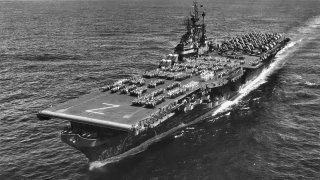Shangri-la: The Essex-Class Aircraft Carrier No Nation Wanted to 'Test'
USS Shangri-La (CV-38) was an Essex-class aircraft carrier launched in 1944 and commissioned with Captain James D. Barner at the helm. Designed to be longer, wider, and heavier than its predecessors, it embodied the escalation in naval capabilities following the repudiation of the Five Powers Treaty by Italy and Japan in the late 1930s.
What You Need to Know: USS Shangri-La (CV-38) was an Essex-class aircraft carrier launched in 1944 and commissioned with Captain James D. Barner at the helm. Designed to be longer, wider, and heavier than its predecessors, it embodied the escalation in naval capabilities following the repudiation of the Five Powers Treaty by Italy and Japan in the late 1930s.
-Measuring approximately 890 feet in length and displacing over 27,100 tons, Shangri-La featured improved armor and larger flight decks to accommodate more aircraft. During World War II, her air group successfully struck Japanese radar and radio installations.
-Post-war, she participated in Operation Crossroads atomic bomb tests and was reclassified as an attack carrier in the 1950s. Shangri-La earned three battle stars during the Vietnam War before being decommissioned in 1971 and stricken from the Naval Vessel Register in 1982.
USS Shangri-La: An Essex-Class Icon's Impact on Warfare
Shangri-la was laid down by the Norfolk Navy Yard at Portsmouth Virginia in 1943. She officially launched one year later and was commissioned with Captain James D. Barner in command.
Like her sister ships, Shangri-la was designed longer, wider and heavier than her predecessors. Once the Five Powers Treaty signed by the major WWI Allied powers was repudiated by Italy and Japan in the late 1930’s, all prior limitations impacting carrier sizes and capabilities were off the table. The Navy’s Essex-class carriers exemplified the new arms race that was emerging.
Specs & capabilities:
Shangri-la measured at roughly 890 feet in length with a displacement of more than 27,100 tons. Comparably, the previous Yorktown-class carriers were approximately one-third lighter in size. CV-38 also incorporated improved armor protection and larger flight decks.
Around this time, aviation capabilities were developing rapidly and carriers were being built to launch as many aircraft as possible.
By the end of the Second World War, the use of catapult launches increased tremendously with some carrier commanding officers reporting up to 40% of launches by catapult.
Operational history:
When USS Shangri-la first launched, she joined destroyer Harry E. Hubbard (DD-748) and large cruiser Guam (CB-2) and sailed for Panama en route to Pearl Harbor. Once she underwent carrier-landing qualifications, she joined Task Group 58.4, where her air group launched their first strikes against Japan.
Shangri-la’s launched aircraft successfully took out Japanese radar and radio installations.
Following the war, Shangri-la commenced normal operations out of San Diego. In 1946, she participated in the Operation Crossroads atomic bomb tests in the Central Pacific. One year later, she deployed again to Pearl Harbor and Australia before being decommissioned in 1947.
USS Shangri-la was reclassified as an attack carrier after re-entering service in the early 1950’s. A whopping $7 million overhaul resulted in an array of improvements on the carrier. She was fitted with twin steam catapults, aircraft elevators and arresting gear.
During the Vietnam War, USS Shangri-la continued her Second Fleet and Sixth Fleet assignments. She earned three battle stars for her service in the war. In 1965, Shangri-la suffered her greatest tragedy in 1965, when the destroyer Newman K. Perry accidently rammed her during war exercises, resulting in one death.
Shangri-la officially decommissioned in 1971 and was placed in the Atlantic Reserve Fleet and berthed at the Philadelphia Naval Shipyard. For the next eleven years, she remained in the reserve fleet before being finally stricken from the Naval Vessel Register in 1982.
About the Author: Maya Carlin, Defense Expert
Maya Carlin, National Security Writer with The National Interest, is an analyst with the Center for Security Policy and a former Anna Sobol Levy Fellow at IDC Herzliya in Israel. She has by-lines in many publications, including The National Interest, Jerusalem Post, and Times of Israel. You can follow her on Twitter: @MayaCarlin.
Image Credit: Creative Commons


